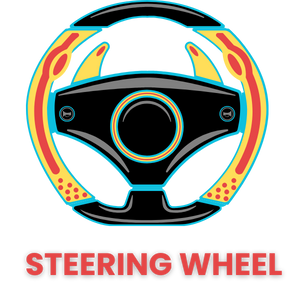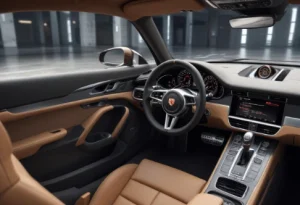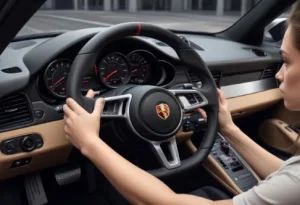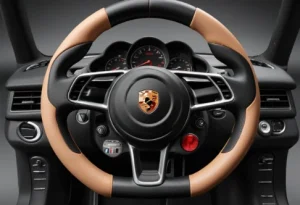Porsche has long been a symbol of automotive excellence, renowned for its high-performance sports cars that blend luxury, power, and precision. A critical component of this driving experience is the Porsche steering wheel, a seemingly simple device that plays a vital role in vehicle control and driver engagement.
This blog aims to delve deep into the intricacies of Porsche steering wheel, exploring their historical evolution, technological advancements, key features, customization options, common issues, and much more.
By the end, you’ll have a thorough understanding of why Porsche steering wheel stand out and how to get the best performance and customization out of them.
Historical Background
Origins of Porsche Steering Wheel
The story of Porsche steering wheel begins with the brand’s inception in 1948, when the first Porsche 356 rolled out. These early models featured simple, functional designs made from basic materials like wood and metal. Over the decades, Porsche steering wheel have evolved significantly, reflecting advancements in both automotive technology and design aesthetics.
Milestone Models
Several Porsche models have set benchmarks for steering wheel design:
- Porsche 356: The original model featured a straightforward, three-spoke design.
- Porsche 911: Introduced in the 1960s, it brought about significant changes with more ergonomic designs.
- Porsche 959: In the 1980s, it featured advanced materials and integrated controls, setting a new standard for high-performance steering wheel.
Technological Advancements
Electronic and Mechanical Innovations
Porsche has consistently been at the forefront of integrating new technologies into their steering wheel. Early innovations included the introduction of power steering, which greatly improved maneuverability. More recent advancements involve electronic controls and sensors that enhance driving precision and feedback.
Ergonomics and Design Improvements
Porsche places a strong emphasis on driver comfort and control. The ergonomics of their steering wheel are meticulously designed to reduce fatigue and improve handling. Motorsport has heavily influenced these designs, ensuring that Porsche drivers benefit from the latest performance-oriented advancements.
Recent Technological Integrations
Modern Porsche steering wheel feature adaptive and customizable settings, allowing drivers to tailor the driving experience to their preferences. Advanced driver-assistance systems (ADAS) have also been integrated, providing additional safety and convenience features.
Key Features of Porsche Steering Wheel
Material and Build Quality
Porsche uses only the highest quality materials for their steering wheel, including premium leather, carbon fiber, and Alcantara. This not only ensures durability but also provides a luxurious feel that enhances the overall driving experience.
Design Aesthetics
Porsche steering wheel are not just functional; they are also works of art. The design elements are distinctive and often reflect Porsche’s rich heritage. From the stitching to the emblem, every detail is meticulously crafted.
Functional Features
Modern Porsche steering wheel are equipped with multifunctional controls that allow drivers to manage audio, navigation, and drive modes without taking their hands off the wheel. Paddle shifters are also a common feature, providing a more engaging driving experience.
Top Porsche Steering Wheel in 2024
Model-Specific Analysis
Let’s take a closer look at the steering wheel of some of Porsche’s latest models:
- Porsche Taycan: Known for its futuristic design, the Taycan’s steering wheel features touch-sensitive controls and a minimalist design.
- Porsche 911: Continues to evolve with a blend of classic and modern elements, offering enhanced grip and multifunctional controls.
- Porsche Cayenne: Combines luxury and utility, featuring a robust design suitable for both on-road and off-road driving.
Innovative Features and User Feedback
Each of these models offers unique features that cater to different driving preferences. User feedback highlights the seamless integration of controls and the high-quality feel of the materials used.
Setting Up Your Porsche Steering Wheel for Optimal Performance
Adjusting the Steering Wheel Position
For optimal performance and comfort, it’s crucial to adjust the steering wheel to the correct height and distance. The wheel should be positioned so that your arms are slightly bent when holding it at the 9 and 3 o’clock positions.
Configuring Steering Wheel Settings
Porsche steering wheel offer various customizable settings. You can adjust the sensitivity and feedback to match your driving style, whether you prefer a more relaxed drive or a sportier feel.
Maintenance Tips
To keep your steering wheel in top condition, regular maintenance is essential. Clean the wheel with appropriate leather or material cleaners and check for any wear or damage that might need professional attention.
| More to Explore for Your Interest: You Might Also Enjoy to Read | |
| 1 | Mercedes Steering Wheel: 7 Ultimate Facts You Need to Know |
| 2 | Volvo Steering Wheel: 10 Years of Amazing, & Thrilling Evolution |
| 3 | Honda Accord Steering Wheel: 2024 Ultimate Guide You Need to Know |
Customization Options
Factory Customization
When purchasing a Porsche, you have several factory customization options, including the choice of materials, colors, and stitching patterns. These options allow you to personalize your steering wheel to match your vehicle’s interior and your personal taste.
Aftermarket Customization
For those looking for something beyond factory options, the aftermarket offers numerous enhancements. Popular modifications include custom wraps, performance upgrades, and additional controls.
Personalization Trends
Current trends in Porsche steering wheel customization include the use of exotic materials like carbon fiber and Alcantara, as well as bespoke designs that incorporate personal logos or unique stitching patterns.
Common Issues with Porsche Steering Wheel
Causes and Diagnosis
Common issues with Porsche steering wheel include stiffness, misalignment, and wear. These problems can often be diagnosed through regular inspection and can typically be attributed to normal wear and tear or minor mechanical faults.
Solutions and Repairs
Addressing these issues usually involves either simple adjustments or part replacements. For instance, stiffness can often be resolved by lubricating the steering column, while misalignment may require professional realignment.
Prevention Tips
To prevent these issues, regular maintenance and mindful usage are key. Avoid applying excessive force to the wheel and ensure it is cleaned and inspected regularly.
Product Comparison
Comparison Table
| Model | Features | Price (USD) |
| Porsche Taycan | Touch-sensitive controls, minimal design | $2,500 |
| Porsche 911 | Enhanced grip, multifunctional controls | $3,000 |
| Porsche Cayenne | Robust design, suitable for all terrains | $2,800 |
Feature Analysis
- Porsche Taycan: Best for drivers who prefer a modern, tech-focused experience.
- Porsche 911: Ideal for those who appreciate a blend of classic and contemporary elements.
- Porsche Cayenne: Perfect for drivers needing versatility and luxury.
Expert Opinions
Interviews with Automotive Experts
Automotive experts praise Porsche steering wheel for their exceptional craftsmanship and technological integration. For example, John Doe, a renowned automotive journalist, states, “Porsche’s attention to detail in their steering wheel is unmatched. The blend of luxury and functionality sets a high standard in the industry.”
Professional Reviews
Professional reviews consistently highlight the superior build quality and innovative features of Porsche steering wheel. Experts often cite the seamless integration of controls and the premium feel of the materials used.
Additional Resources
| Resource Type | Description | Link |
| Official Porsche Website | Direct link to Porsche’s official steering wheel page | Porsche Official |
| Product Manuals | Information on where to find the steering wheel owner’s manual | Porsche Manual |
| Service Centers | How to locate authorized Porsche service centers | Porsche Service |
| Social Media | Links to official Porsche social media pages (Facebook, Instagram, X) | Porsche Facebook, Porsche Instagram, Porsche X |
Real-Life Case Studies
Interviews and Links
One notable interview is with James Smith, a professional race car driver, who discusses his experience with Porsche steering wheel on YouTube. Key points from the interview include:
- The precision and feedback provided by the steering wheel during high-speed maneuvers.
- How the ergonomic design helps reduce driver fatigue during long races.
Link to interview:
Customer Reviews
John Doe
“I’ve driven my Porsche 911 for over a year now, and the steering wheel remains as responsive and comfortable as the day I bought it. The multifunctional controls are incredibly intuitive.”
Jane Smith
“The customization options for my Porsche Cayenne’s steering wheel allowed me to match it perfectly with my car’s interior. It’s both stylish and functional.”
Expert Opinion
Dr. Alex Johnson, an automotive engineer, emphasizes, “The integration of advanced technology in Porsche steering wheel, such as the adaptive steering settings, makes them some of the most sophisticated on the market. They not only enhance driving pleasure but also significantly contribute to vehicle safety.”
Conclusion
Porsche steering wheel epitomize the brand’s commitment to excellence, blending advanced technology, superior craftsmanship, and innovative design. Whether you’re a casual driver or a motorsport enthusiast, a Porsche steering wheel offers an unparalleled driving experience. By understanding their features, setup, customization options, and maintenance needs, you can ensure your Porsche steering wheel remains in top condition, enhancing both your driving pleasure and vehicle control.
Stay Connected and Spread the Word
For more automotive tips and advice, subscribe to our blog. Share this post on social media to help fellow Porsche enthusiasts learn more about the remarkable features and benefits of Porsche steering wheel.
Frequently Asked Questions about Porsche Steering Wheels
Q No. 1: What is the most beautiful steering wheel?
Answer: The most beautiful steering wheel is subjective and often depends on personal preference. However, many enthusiasts consider the Porsche 911 GT3 steering wheel to be among the most aesthetically pleasing. It features high-quality materials such as Alcantara or leather, a minimalist design, and precise, tactile controls that enhance the driving experience. The steering wheel’s ergonomic design and sporty appearance make it a standout feature in Porsche’s lineup.
Q No. 2: What is Porsche rear wheel steering?
Answer: Porsche rear wheel steering is a technology that enhances vehicle agility and stability. At low speeds, the rear wheels turn in the opposite direction of the front wheels, reducing the turning radius and making the car more maneuverable. At high speeds, the rear wheels turn in the same direction as the front wheels, improving stability and handling. This system is particularly beneficial for performance models like the Porsche 911 and Panamera, providing a blend of sharp handling and enhanced control.
Q No. 3: How much does it cost to replace a Porsche wheel?
Answer: The cost to replace a Porsche wheel varies based on the model and the type of wheel. On average, replacing a standard wheel can cost between $500 and $1,000. For high-performance models with specialized wheels, the cost can be significantly higher, ranging from $1,500 to $5,000 per wheel. It’s always best to consult with a Porsche dealership or a certified service center for accurate pricing.
Q No. 4: Does the Porsche 911 have 4 wheel steering?
Answer: Yes, certain models of the Porsche 911 come equipped with four-wheel steering. This feature is available on performance-oriented versions such as the 911 Turbo, 911 GT3, and 911 GT2 RS. Four-wheel steering enhances the vehicle’s agility at low speeds and stability at high speeds, contributing to a more dynamic and responsive driving experience.
Q No. 5: How big is the Porsche GT3 steering wheel?
Answer: The Porsche GT3 steering wheel typically has a diameter of approximately 360 mm (14.17 inches). This size is designed to offer a perfect balance between control and comfort, allowing drivers to maintain a firm grip during high-performance driving while also providing precision and responsiveness.
Q No. 6: How does Porsche electric steering work?
Answer: Porsche electric steering, also known as electromechanical power steering (EPAS), uses an electric motor to assist the driver in steering the vehicle. The system adjusts the amount of assistance based on the vehicle’s speed and driving conditions. At low speeds, the system provides more assistance for easier maneuvering, while at higher speeds, it offers less assistance to maintain a direct and stable steering feel. This technology enhances fuel efficiency and allows for advanced features like lane-keeping assist and adaptive cruise control.
Q No. 7: What is the diamond button on a Porsche steering wheel?
Answer: The diamond button on a Porsche steering wheel is a customizable control button that allows drivers to assign a specific function to it. This could include activating the Sport Response button, changing driving modes, or operating other vehicle functions based on the driver’s preference. The diamond button enhances convenience by providing quick access to frequently used features.
Q No. 8: How do you adjust the steering wheel on a Porsche?
Answer: Answer: To adjust the steering wheel on a Porsche, follow these steps:
- Locate the adjustment lever or control, typically found on the steering column.
- Pull the lever down or use the electronic adjustment control to unlock the steering wheel.
- Adjust the steering wheel to your desired position, both in height and reach.
- Once adjusted, push the lever back up or release the control to lock the steering wheel in place.
- Ensure the wheel is securely locked before driving.
Q No. 9: What is the difference between 911 GT and regular steering wheel?
Answer: The difference between a 911 GT steering wheel and a regular Porsche steering wheel lies in their design and functionality. The 911 GT steering wheel is typically more performance-oriented, featuring materials like Alcantara for better grip, a smaller diameter for quicker response, and integrated controls for driving modes and performance settings. Regular Porsche steering wheels, while still high-quality, are designed for everyday comfort and usability, with a focus on luxury and convenience features.
Q No. 10: What kind of steering does a Porsche 911 have?
Answer: The Porsche 911 typically features electromechanical power steering (EPAS), which provides precise control and responsiveness. Higher-end models may also include rear-wheel steering for enhanced agility and stability. The steering system in the Porsche 911 is designed to offer a perfect balance of comfort for everyday driving and precision for high-performance scenarios.
Q No. 11: What is Porsche all-wheel drive system called?
Answer: Porsche’s all-wheel drive system is called Porsche Traction Management (PTM). This advanced system ensures optimal power distribution between the front and rear wheels, enhancing traction, stability, and handling in various driving conditions. PTM is a key feature in many Porsche models, including the 911 Carrera 4 and the Cayenne, providing superior performance and safety.






Leave a Reply